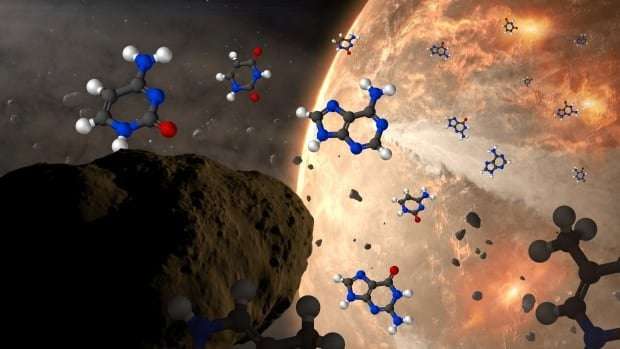A fresh examination of meteorites that landed in the United States, Canada and Australia is bolstering the notion that early in Earth's history, such objects may have delivered chemical ingredients vital for the advent of life.
Scientists had previously detected on these meteorites three of the five chemical components needed to form DNA, the molecule that carries genetic instructions in living organisms, and RNA, the molecule crucial for controlling the actions of genes. Researchers said on Tuesday they have now identified the final two after fine-tuning the way they analyzed the meteorites.
Unlike in previous work, the methods used this time were more sensitive and did not use strong acids or hot liquid to extract the five components, known as nucleobases, according to astrochemist Yasuhiro Oba of Hokkaido University's Institute of Low Temperature Science in Japan, lead author of the study published in the journal Nature Communications.
Nucleobases are nitrogen-containing compounds crucial in forming DNA's characteristic double-helix structure.
Confirmation of an extraterrestrial origin of a complete set of nucleobases found in DNA and RNA buttresses the theory that meteorites could have been an important source of organic compounds necessary for the emergence of Earth's first living organisms, according to astrobiologist and study co-author Danny Glavin of NASA's Goddard Space Flight Center in Maryland.
The Tagish Lake meteorite fell in northern British Columbia on Jan. 18, 2000. It produced a remarkable fireball as it streaked across the dawn sky, which was witnessed as far away as Whitehorse, Yukon. (Royal Ontario Museum)
Scientists have been seeking to better understand the events that unfolded on Earth that enabled various chemical compounds to come together in a warm, watery setting to form a living microbe able to reproduce itself. The formation of DNA and RNA would be an important milestone, as these molecules essentially contain the instructions to build and operate living organisms.
"There is still much to learn about the chemical steps that led to the origin of life on Earth — the first self-replicating system," Glavin said. "This research certainly adds to the list of chemical compounds that would have been present in the early Earth's prebiotic [existing before the emergence of life] soup."
The researchers examined material from three meteorites — one that fell in 1950 near the town of Murray in the U.S. state of Kentucky; one that fell in 1969 near the town of Murchison in Australia's Victoria state; and one that fell in 2000 near Tagish Lake in B.C.
On the morning of January 18, 2000 a blue-green fireball streaked through the sky & crashed into frozen Lake Tagish, in NW BC. It was a stony (chondrite) meteorite. Scanning electron microscope photo shows framboidal (raspberry-like) crystals of magnetite. <a href="https://twitter.com/hashtag/ThrowbackThursday?src=hash&ref_src=twsrc%5Etfw">#ThrowbackThursday</a> <a href="https://twitter.com/hashtag/tbt?src=hash&ref_src=twsrc%5Etfw">#tbt</a> <a href="https://t.co/yy9ReYgpUC">pic.twitter.com/yy9ReYgpUC</a> —@GSC_CGC
All three are classified as carbonaceous chondrites, made of rocky material thought to have formed early in the solar system's history. They are carbon-rich, with the Murchison and Murray meteorites containing about two per cent organic carbon by weight and the Tagish Lake meteorite containing about four per cent organic carbon. Carbon is a primary constituent of organisms on Earth.
"All three meteorites contain a very complex mixture of organic molecules, most of which have not yet been identified," Glavin said.
Earth formed roughly 4.5 billion years ago. In its infancy, it was pelted by meteorites, comets and other material from space. The planet's first organisms were primitive microbes in the primordial seas, and the earliest known fossils are marine microbial specimens dating to roughly 3.5 billion years ago, though there are hints of life in older fossils.
The two nucleobases, called cytosine and thymine, newly identified in the meteorites may have eluded detection in previous examinations because they possess a more delicate structure than the other three, the researchers said.
<a href="https://twitter.com/hashtag/DYK?src=hash&ref_src=twsrc%5Etfw">#DYK</a>: The Meteorite Collection in <a href="https://twitter.com/UofA_EAS?ref_src=twsrc%5Etfw">@UofA_EAS</a> is one of Canada’s largest university-based meteorite collection and houses 1,100 samples? This includes the Tagish Lake & Bruderheim meteorites!<br><br>Discover more about this <a href="https://twitter.com/hashtag/UAlbertaMuseums?src=hash&ref_src=twsrc%5Etfw">#UAlbertaMuseums</a> collection: <a href="https://t.co/pblndmPpzs">https://t.co/pblndmPpzs</a> <a href="https://twitter.com/hashtag/UAlberta?src=hash&ref_src=twsrc%5Etfw">#UAlberta</a> <a href="https://t.co/XBitMok0Ei">pic.twitter.com/XBitMok0Ei</a> —@UAlbertaMuseums
The five nucleobases would not have been the only chemical compounds necessary for life. Among other things needed were: amino acids, which are components of proteins and enzymes; sugars, which are part of the DNA and RNA backbone; and fatty acids, which are structural components of cell membranes.
"The present results may not directly elucidate the origin of life on the Earth," Oba said, "but I believe that they can improve our understanding of the inventory of organic molecules on the early Earth before the onset of life."

danktle on May 3rd, 2022 at 10:32 UTC »
This is also on r/space. I don't know why people want to believe that earth was completely barren until one special asteroid brought us amino acids. It is entirely possible that several formation rocks during heavy bombardment contained the necessary elements and compounds to create DNA. It's entirely possible we started here based on the evolution of the parent star system long before the Sun ignited. Perhaps it also had life.
I'm guessing that the entire dust cloud that built the solar system contained healthy amounts of elements, compounds, and molecules that were necessary to create the world we live in. The Earth wasn't "just some barren rock until the cosmic divine sent us this one asteroid...".
We are literally the result of star dust where most elements bigger than hydrogen and helium come from. Those atoms aren't "sitting in just this one special place." It's everywhere and in any place beyond the first cosmic generation of stars.
TL;DR: I'm saying life is more prevalent than one asteroid we found.
Heeper on May 3rd, 2022 at 10:27 UTC »
So... former British territories? I knew the Queen was up to something...
kstinfo on May 3rd, 2022 at 10:08 UTC »
This will drive the religious right straight up the wall.